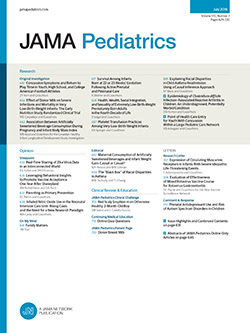Testing Bidirectional Associations Between Maternal and Child Depression During Emerging Adolescence
IF 18
1区 医学
Q1 PEDIATRICS
引用次数: 0
Abstract
ImportanceResearch has consistently shown links between parent and child depression. The prevailing assumption is that parent depression precedes the onset, persistence, and even exacerbation of child depression. However, it is plausible, albeit infrequently tested, that child depression triggers subsequent parent depression. Clarifying the direction and developmental timing of these associations is critical for designing and advocating for family-centered approaches to pediatric care.ObjectiveTo estimate the longitudinal bidirectional associations between maternal and child depression from middle childhood through emerging adolescence during a period that coincided with the COVID-19 pandemic, and to assess whether these associations are moderated by key sociodemographic factors.Design, Setting, and ParticipantsThis study used data from the All Our Families (Calgary, Alberta, Canada) cohort across multiple waves during and beyond the COVID-19 pandemic when children were aged 10.3 (May 20 to July 15, 2020), 10.9 (March 4 to April 30, 2021), 11.6 (November 22, 2021 to January 17, 2022), and 12.8 (January 16 to July 7, 2024) years. Data were analyzed between March 1 and August 31, 2024, using random-intercept cross-lagged panel models.ExposuresMaternal and child report of depressive symptoms.Main Outcomes and MeasuresThe Behavior Assessment System for Children for child depression and the Center for Epidemiologic Studies Depression Scale-10 for maternal depression.ResultsThe sample included 1801 mother-child dyads (52% boys, 48% girls). Mothers were a mean (SD) 41.6 (4.4) years old at study entry and most had completed postsecondary education (80%), had an annual income more than CAD $100 000 (75%), and were married or in common-law relationships (71.4%). Consistent cross-sectional correlations were observed, reflecting stable between-participant associations for maternal depression and child depression throughout the study period. Within-participant increases in child depression scores at ages 10.3 and 10.9 years were associated with subsequent increases in maternal depression scores at child ages 10.9 (standardized coefficient 0.12; 95% CI, 0.02-0.22) and 11.6 (0.17; 95% CI, 0.07-0.26) years; however, this was not present for maternal depression. These patterns of associations were moderated by household income (difference test for χ初出期青春期母亲与儿童抑郁的双向关联检验
研究一直表明父母和孩子抑郁之间存在联系。普遍的假设是父母抑郁先于儿童抑郁的发作、持续甚至恶化。然而,这似乎是合理的,尽管很少被测试,儿童抑郁症引发随后的父母抑郁症。明确这些关联的方向和发展时机对于设计和倡导以家庭为中心的儿科护理方法至关重要。目的评估与COVID-19大流行同时发生的从童年中期到青春期初的母婴抑郁之间的纵向双向关联,并评估这些关联是否受到关键社会人口因素的调节。设计、环境和参与者本研究使用了来自我们所有家庭(加拿大阿尔伯塔省卡尔加里)队列的数据,这些数据来自2019冠状病毒病大流行期间和之后的多个浪潮,儿童年龄为10.3(2020年5月20日至7月15日)、10.9(2021年3月4日至4月30日)、11.6(2021年11月22日至2022年1月17日)和12.8(2024年1月16日至7月7日)。使用随机截距交叉滞后面板模型分析了2024年3月1日至8月31日之间的数据。产妇和儿童报告抑郁症状。儿童抑郁行为评估系统和流行病学研究中心抑郁量表-10用于母亲抑郁。结果共纳入1801对母子,其中男孩52%,女孩48%。研究开始时,母亲的平均年龄为41.6(4.4)岁,大多数完成了高等教育(80%),年收入超过10万加元(75%),已婚或同居(71.4%)。观察到一致的横断面相关性,反映了在整个研究期间,母亲抑郁和儿童抑郁在参与者之间的稳定关联。10.3岁和10.9岁儿童抑郁评分的参与者内增加与随后10.9岁儿童(标准化系数0.12;95% CI, 0.02-0.22)和11.6岁(0.17;95% CI, 0.07-0.26)母亲抑郁评分的增加相关;然而,这并不存在于母亲抑郁症中。这些关联模式受到家庭收入的影响(χ212 = 23.0; P = 0.03的差异检验),在高收入组中,儿童抑郁症的增加与随后母亲抑郁症的增加一致相关。结论和相关性与普遍的假设相反,这些发现表明,随着时间的推移,儿童的抑郁可能会导致母亲抑郁的恶化,而不是相反。虽然这些结果应在非大流行背景下得到复制,以确认其普遍性,但它们强调了以家庭为中心的精神卫生保健方法的必要性。
本文章由计算机程序翻译,如有差异,请以英文原文为准。
求助全文
约1分钟内获得全文
求助全文
来源期刊

JAMA Pediatrics
PEDIATRICS-
CiteScore
31.60
自引率
1.90%
发文量
357
期刊介绍:
JAMA Pediatrics, the oldest continuously published pediatric journal in the US since 1911, is an international peer-reviewed publication and a part of the JAMA Network. Published weekly online and in 12 issues annually, it garners over 8.4 million article views and downloads yearly. All research articles become freely accessible online after 12 months without any author fees, and through the WHO's HINARI program, the online version is accessible to institutions in developing countries.
With a focus on advancing the health of infants, children, and adolescents, JAMA Pediatrics serves as a platform for discussing crucial issues and policies in child and adolescent health care. Leveraging the latest technology, it ensures timely access to information for its readers worldwide.
 求助内容:
求助内容: 应助结果提醒方式:
应助结果提醒方式:


